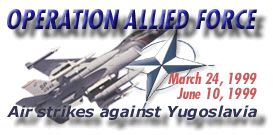Cruise missile stock depletion

During the air campaign, the USAF inventory of conventionally armed cruise missiles was rapidly depleting by the heavy use against Yugoslavia. The United Kingdom was also using cruise missiles.
British Navy — The British Royal Navy launched a small number of Tomahawk BGM-109s from the nuclear submarine Splendid. The UK had/has a contract with Raytheon for the delivery of 65 BGM-109s. The majority of the missiles are yet to be delivered (June 1999).
US Navy — The US Navy used the heavier Tomahawk Land Attack Missile (TLAM), launching them from surface ships. Originally, the stock was 2,200 missiles. In 1991 several hundreds were used against Iraqi targets and during the four-day attack on Iraq in December 1998, the US Navy fired some 300 TLAMs.
US Air Force — The USAF used the heaviest cruise missile: the AGM-86C, of which Boeing manufactured 1,715, until production was ceased in 1986, in anticipation of an improved missile that was not yet available. Starting up production again would take up to a year. At the beginning of the air strikes only 150 AGM-86Cs with conventional munitions were available. B-52H bombers launched 50 (May 1999). The B-52 are capable of carrying 20 cruise missiles, but during Operation Allied Force they have been fitted with only eight.
On April 22, 1999, the Pentagon awarded a $41 million contract to Boeing to convert 95 nuclear-armed cruise missiles to the non-nuclear version that B-52 bombers were launching at Yugoslavia. The work is scheduled to be finished by November 30, 1999 (May 1999).